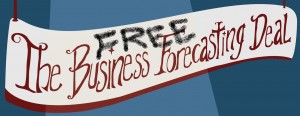Free The BFD
 The BFD has been on a short hiatus, fending off potential litigation with the organizing committee of a quadrennial international sporting event that isn't the World Cup. Per the advice of SAS Legal, I've had to make a few changes to the May 30 post, now entitled "Forecasting [quadrennial international sporting event that isn't the World Cup]medals." Thank you for your patience and support, and the generous contributions to my legal defense fund.
The BFD has been on a short hiatus, fending off potential litigation with the organizing committee of a quadrennial international sporting event that isn't the World Cup. Per the advice of SAS Legal, I've had to make a few changes to the May 30 post, now entitled "Forecasting [quadrennial international sporting event that isn't the World Cup]medals." Thank you for your patience and support, and the generous contributions to my legal defense fund.
The Objectives of Forecasting
In the narrow sense, the objective of forecasting is to produce better forecasts. But in the broader sense, the objective is to improve organizational performance—more revenue, more profit, increased customer satisfaction. Better forecasts, by themselves, are of no inherent value if those forecasts are ignored by management or otherwise not used to improve organizational performance.
A wonderfully sinister way to improve forecast accuracy (while ignoring more important things like order fill, customer satisfaction, revenue generation, and profit) was provided by Ruud Teunter of Lancaster University, at the 2008 International Symposium on Forecasting. Teunter compared various forecasting methods for a data set of 5,000 items having intermittent demand patterns. (Intermittent patterns have zero demand in many or most time periods.)
Teunter found that if the goal is simply to minimize forecast error, then forecasting zero in every period was the best method to use! (The zero forecast had lower error than a moving average, exponential smoothing, bootstrapping, and three variations of Croston’s method that were tested.) However, for proper inventory management to serve customer needs, forecasting zero demand every period is probably not the right thing to do.
A similar point was made last fall in a Foresight article by Stephan Kolassa and Roland Martin (discussed in "Tumbling Dice"). Using a simple dice tossing experiment, they showed the implications for bias in commonly used percentage error metrics. What makes this important to management is that if the sole incentive for forecasters is to minimize MAPE, the forecaster could do best by purposely forecasting too low. This, of course, could have bad consequences for inventory management and customer service.
